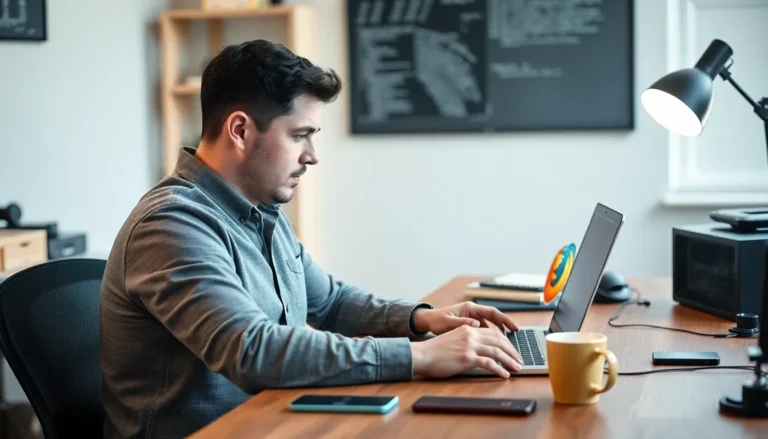In a world where secrets can be as fleeting as a Snapchat message, keeping your iPhone secure is more important than ever. Imagine the horror of realizing someone’s been snooping through your texts or, worse, your cat memes. It’s enough to make anyone check their phone like it’s a bomb about to go off.
Table of Contents
ToggleOverview of iPhone Security
iPhone security plays a crucial role in protecting user data from unauthorized access. Device encryption safeguards personal information, ensuring that data stored on the device remains protected. The iPhone’s built-in security features, such as Face ID and Touch ID, add an additional layer of protection, requiring biometric authentication to unlock the device.
Regular software updates enhance security measures by addressing vulnerabilities. Users should enable automatic updates to ensure they benefit from the latest security patches. Strong passcodes also improve security; a six-digit numeric code or alphanumeric passcode offers better protection than a simple four-digit code.
Privacy settings are vital for controlling app permissions. Users can restrict access to sensitive information, such as location data and contacts, ensuring that only trusted applications can access personal information. Furthermore, the option to enable two-factor authentication adds an extra layer of security, requiring verification from a trusted device before granting access.
Monitoring device storage can reveal unauthorized access. Unrecognized apps or unusual data use may indicate that someone has compromised the device. Users should review app permissions periodically to maintain control over their personal information.
Find My iPhone is a useful feature for tracking lost devices and remotely locking them. Enabling this feature ensures that personal data remains secure if the device is lost or stolen. Awareness of these security measures can significantly enhance user confidence in their iPhone’s ability to protect sensitive information.
Signs That Someone Might Have Access

Recognizing signs that someone accessed an iPhone can prevent further privacy breaches. Several indicators can reveal unauthorized usage.
Unusual Activity On Your Accounts
Unusual activity on accounts linked to the iPhone raises red flags. Users might notice login attempts from unfamiliar devices or locations. Unauthorized purchases often reflect compromised credentials. Notifications about password changes or unfamiliar sign-ins should prompt immediate investigation. Frequent app usage from unknown sources also signals potential breaches. Checking for unfamiliar social media messages can reveal if someone’s spying on personal conversations. Users can monitor their app activity for any strange interactions. Vigilance helps users identify if someone leverages their iPhone access for malicious purposes.
Unexpected Changes In Settings
Unexpected changes in settings highlight possible unauthorized access. Users might find altered password settings or new security questions without their knowledge. Disturbingly, the addition of unfamiliar accounts can compromise the device’s permissions. Activation of features like “Find My iPhone” without consent raises concerns. Privacy settings may appear modified, allowing apps greater access than intended. Users ought to watch for modified notification preferences as well. Restoring any altered settings to original configurations helps regain control. Awareness of these shifts contributes to a proactive approach against breaches.
How To Check Your iPhone For Unauthorized Access
Checking for unauthorized access on your iPhone involves a few key steps that can help uncover any suspicious activity.
Review Installed Apps
Inspect the list of installed apps regularly. Unrecognized applications may signal unauthorized access. Tap on the App Store, then select your profile to view the purchased apps. Look for any apps he or she didn’t download. Searching for unfamiliar names can help identify potential threats. Delete any app that raises concern. Additionally, ensure app permissions align with your personal data privacy preferences. Keeping apps updated also fortifies security against vulnerabilities.
Check for VPNs and Profiles
Look for any VPNs or configuration profiles installed on the device. Open the Settings app and navigate to General. Here, tap on VPN to check for any active configurations. Removing unfamiliar VPNs can reduce the risk of unauthorized access. Next, access the Profiles menu under General settings to review any profiles. Profiles can enable third-party applications to access certain device features. Delete any profiles that appear unfamiliar or unnecessary. A careful review of these elements fortifies the iPhone against potential privacy breaches.
Enhancing Your iPhone Security
Increasing iPhone security involves several proactive steps. Enabling Face ID or Touch ID serves as a strong line of defense against unauthorized access. Using a complex passcode further bolsters this layer of protection.
Regular software updates play a critical role in security; they patch vulnerabilities that malicious actors may exploit. Individuals should activate automatic updates, ensuring the device always runs the latest software version.
Privacy settings require attention as they dictate app permissions. Adjust settings to limit access to sensitive data, such as location and contacts. Monitoring these settings reduces the risk of apps accessing information without consent.
Two-factor authentication adds a robust security measure that protects accounts linked to the iPhone. When enabled, users must confirm their identity through a second method, enhancing overall security.
Frequent checks for unusual apps or data usage help identify potential intrusions. Users should look for unrecognized applications and monitor their device’s storage. Anomalies could signify unauthorized access, prompting immediate action.
Keeping an eye on unusual activities, such as unknown login attempts or unexpected purchases, is key. These occurrences may indicate that someone else is using linked accounts. Take note if passwords suddenly change or unfamiliar accounts appear, as this might signal a security breach.
Lastly, examining installed configuration profiles and VPNs ensures third-party access remains controlled. These elements can unknowingly allow outside parties to utilize device features, so regular inspections are essential. Through these strategies, users can significantly enhance their iPhone’s security and protect sensitive information.
Staying vigilant about iPhone security is essential in today’s digital landscape. By understanding the signs of unauthorized access and implementing robust security measures, users can significantly reduce the risk of privacy breaches. Regularly reviewing app permissions and installed applications helps maintain control over personal data.
Utilizing features like Face ID, Touch ID, and two-factor authentication adds layers of protection. Keeping software updated ensures that any vulnerabilities are addressed promptly. By actively monitoring device activity and settings, users can safeguard their information and enhance their overall confidence in their iPhone’s security. Taking these proactive steps leads to a more secure and private digital experience.



